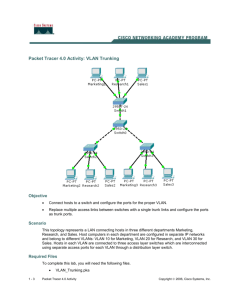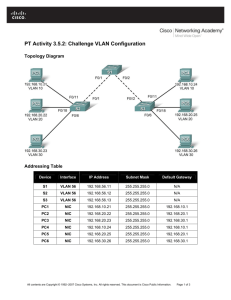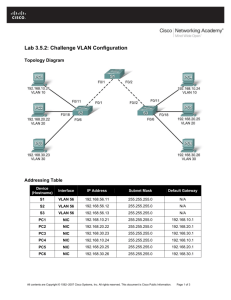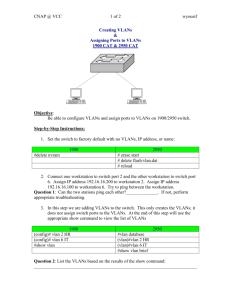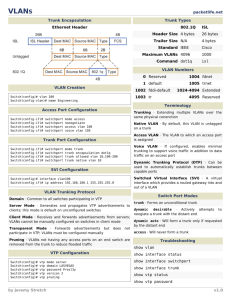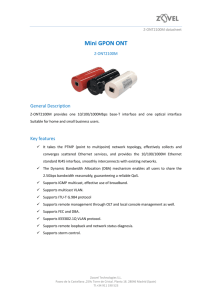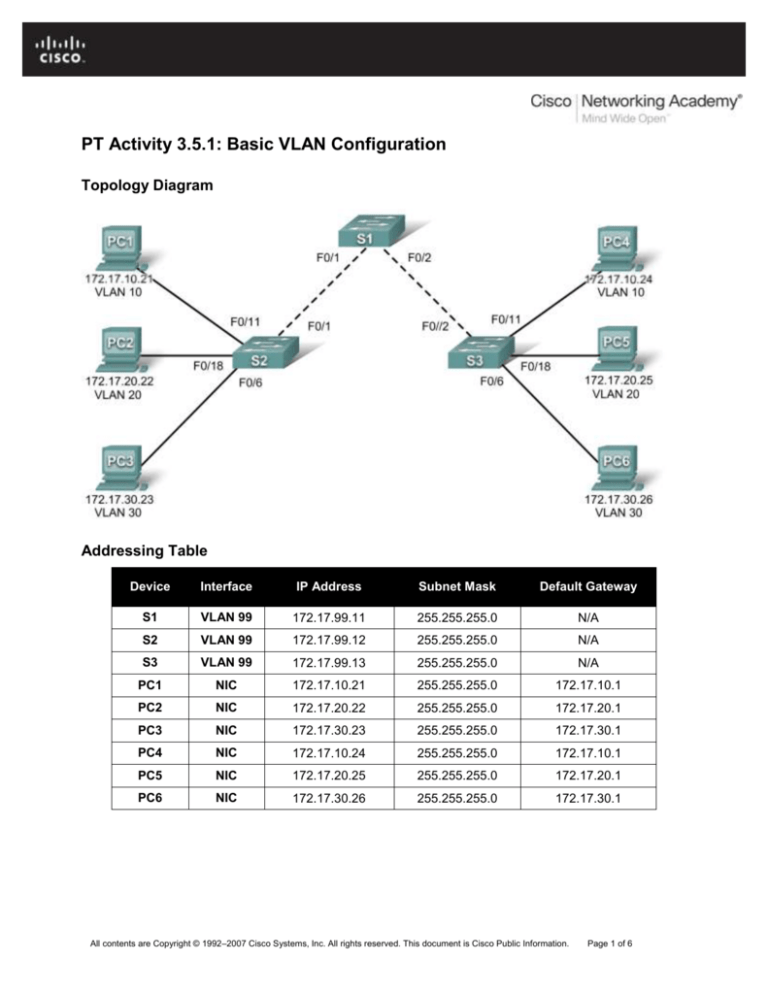
PT Activity 3.5.1: Basic VLAN Configuration
Topology Diagram
Addressing Table
Device
Interface
IP Address
Subnet Mask
Default Gateway
S1
VLAN 99
172.17.99.11
255.255.255.0
N/A
S2
VLAN 99
172.17.99.12
255.255.255.0
N/A
S3
VLAN 99
172.17.99.13
255.255.255.0
N/A
PC1
NIC
172.17.10.21
255.255.255.0
172.17.10.1
PC2
NIC
172.17.20.22
255.255.255.0
172.17.20.1
PC3
NIC
172.17.30.23
255.255.255.0
172.17.30.1
PC4
NIC
172.17.10.24
255.255.255.0
172.17.10.1
PC5
NIC
172.17.20.25
255.255.255.0
172.17.20.1
PC6
NIC
172.17.30.26
255.255.255.0
172.17.30.1
All contents are Copyright © 1992–2007 Cisco Systems, Inc. All rights reserved. This document is Cisco Public Information.
Page 1 of 6
CCNA Exploration
LAN Switching and Wireless: VLANs
PT Activity 3.5.1: Basic VLAN Configuration
Port Assignments (Switches 2 and 3)
Ports
Assignment
Network
Fa0/1 – 0/5
VLAN 99 – Management&Native
172.17.99.0/24
Fa0/6 – 0/10
VLAN 30 – Guest(Default)
172.17.30.0/24
Fa0/11 – 0/17
VLAN 10 – Faculty/Staff
172.17.10.0/24
Fa0/18 – 0/24
VLAN 20 – Students
172.17.20.0/24
Learning Objectives
Perform basic configuration tasks on a switch.
Create VLANs.
Assign switch ports to a VLAN.
Add, move, and change ports.
Verify VLAN configuration.
Enable trunking on inter-switch connections.
Verify trunk configuration.
Save the VLAN configuration.
Task 1: Perform Basic Switch Configurations
Perform basic switch configuration on all three switches.
Configure the switch hostnames.
Disable DNS lookup.
Configure an encrypted privileged EXEC mode password of class.
Configure a password of cisco for console connections.
Configure a password of cisco for vty connections.
Your completion percentage should be 25%. If not, troubleshoot for any errors.
Task 2: Configure and Activate Ethernet Interfaces
From the Desktop, select IP Configuration to configure the Ethernet interfaces of the six PCs with the IP
addresses and default gateways from the addressing table.
Note: The IP address for PC1 will score as incorrect for now. You will change the PC1 IP address later.
Your completion percentage should be 51%. If not, troubleshoot for any errors.
Task 3: Configure VLANs on the Switch
Step 1. Create VLANs on switch S1.
Use the vlan vlan-id command in global configuration mode to add VLANs to switch S1. There are
four VLANs to configure for this activity. After you create the VLAN, you will be in vlan configuration
mode, where you can assign a name to the VLAN with the vlan name command.
S1(config)#vlan 99
S1(config-vlan)#name Management&Native
S1(config-vlan)#exit
All contents are Copyright © 1992–2007 Cisco Systems, Inc. All rights reserved. This document is Cisco Public Information.
Page 2 of 6
CCNA Exploration
LAN Switching and Wireless: VLANs
PT Activity 3.5.1: Basic VLAN Configuration
S1(config)#vlan 10
S1(config-vlan)#name Faculty/Staff
S1(config-vlan)#exit
S1(config)#vlan 20
S1(config-vlan)#name Students
S1(config-vlan)#exit
S1(config)#vlan 30
S1(config-vlan)#name Guest(Default)
S1(config-vlan)#exit
Step 2. Verify that the VLANs have been created on S1.
Use the show vlan brief command to verify that the VLANs have been created.
S1#show vlan brief
VLAN Name
Status
Ports
---- ------------------------------ --------- ------------------------------1
default
active
Fa0/1, Fa0/2, Fa0/4, Fa0/5
Fa0/6, Fa0/7, Fa0/8, Fa0/9
Fa0/10, Fa0/11, Fa0/12, Fa0/13
Fa0/14, Fa0/15, Fa0/16, Fa0/17
Fa0/18, Fa0/19, Fa0/20, Fa0/21
Fa0/22, Fa0/23, Fa0/24, Gi0/1
Gi0/2
10
Faculty/Staff
active
20
Students
active
30
Guest(Default)
active
99
Management&Native
active
Step 3. Configure and name VLANs on switches S2 and S3.
Create and name VLANs 10, 20, 30, and 99 on S2 and S3 using the commands from Step 1. Verify the
correct configuration with the show vlan brief command.
What ports are currently assigned to the four VLANs you have created?
_______________________________________
Step 4. Assign switch ports to VLANs on S2 and S3.
Refer to the port assignment table. Ports are assigned to VLANs in interface configuration mode, using
the switchport access vlan vlan-id command. Packet Tracer will only grade the first interface in
each range (the interface the PC is connected to). Normally you would use the interface range
command, but Packet Tracer does not support this command.
S2(config)#interface fastEthernet0/6
S2(config-if)#switchport mode access
S2(config-if)#switchport access vlan 30
S2(config-if)#interface fastEthernet0/11
S2(config-if)#switchport mode access
S2(config-if)#switchport access vlan 10
S2(config-if)#interface fastEthernet0/18
S2(config-if)#switchport mode access
S2(config-if)#switchport access vlan 20
S2(config-if)#end
S2#copy running-config startup-config
Destination filename [startup-config]? [enter]
Building configuration...
[OK]
All contents are Copyright © 1992–2007 Cisco Systems, Inc. All rights reserved. This document is Cisco Public Information.
Page 3 of 6
CCNA Exploration
LAN Switching and Wireless: VLANs
PT Activity 3.5.1: Basic VLAN Configuration
Note: The Fa0/11 access VLAN will score as incorrect for now. You will correct this later in the activity.
Repeat the same commands on S3.
Step 5. Determine which ports have been added.
Use the show vlan id vlan-number command on S2 to see which ports are assigned to VLAN 10.
Which ports are assigned to VLAN 10? _____________________________________________
Note: The show vlan name vlan-name displays the same output.
You can also view VLAN assignment information using the show interfaces switchport
command.
Step 6. Assign the management VLAN.
A management VLAN is any VLAN that you configure to access the management capabilities of a switch.
VLAN 1 serves as the management VLAN if you did not specifically define another VLAN. You assign the
management VLAN an IP address and subnet mask. A switch can be managed via HTTP, Telnet, SSH,
or SNMP. Because the out-of-the-box configuration of a Cisco switch has VLAN 1 as the default VLAN,
VLAN 1 is a bad choice as the management VLAN. You do not want an arbitrary user who is connecting
to a switch to default to the management VLAN. Recall that you configured the management VLAN as
VLAN 99 earlier in this lab.
From interface configuration mode, use the ip address command to assign the management IP address
to the switches.
S1(config)#interface vlan 99
S1(config-if)#ip address 172.17.99.11 255.255.255.0
S1(config-if)#no shutdown
S2(config)#interface vlan 99
S2(config-if)#ip address 172.17.99.12 255.255.255.0
S2(config-if)#no shutdown
S3(config)#interface vlan 99
S3(config-if)#ip address 172.17.99.13 255.255.255.0
S3(config-if)#no shutdown
Assigning a management address allows IP communication between the switches, and also allows any
host connected to a port assigned to VLAN 99 to connect to the switches. Because VLAN 99 is
configured as the management VLAN, any ports assigned to this VLAN are considered management
ports and should be secured to control which devices can connect to these ports.
Step 7. Configure trunking and the native VLAN for the trunking ports on all switches.
Trunks are connections between the switches that allow the switches to exchange information for all
VLANS. By default, a trunk port belongs to all VLANs, as opposed to an access port, which can only
belong to a single VLAN. If the switch supports both ISL and 802.1Q VLAN encapsulation, the trunks
must specify which method is being used. Because the 2960 switch only supports 802.1Q trunking, it is
not specified in this activity.
A native VLAN is assigned to an 802.1Q trunk port. In the topology, the native VLAN is VLAN 99. An
802.1Q trunk port supports traffic coming from many VLANs (tagged traffic) as well as traffic that does not
come from a VLAN (untagged traffic). The 802.1Q trunk port places untagged traffic on the native VLAN.
Untagged traffic is generated by a computer attached to a switch port that is configured with the native
VLAN. One of the IEEE 802.1Q specifications for Native VLANs is to maintain backward compatibility with
untagged traffic common to legacy LAN scenarios. For the purposes of this activity, a native VLAN serves
All contents are Copyright © 1992–2007 Cisco Systems, Inc. All rights reserved. This document is Cisco Public Information.
Page 4 of 6
CCNA Exploration
LAN Switching and Wireless: VLANs
PT Activity 3.5.1: Basic VLAN Configuration
as a common identifier on opposing ends of a trunk link. It is a best practice to use a VLAN other than
VLAN 1 as the native VLAN.
S1(config)#interface fa0/1
S1(config-if)#switchport mode trunk
S1(config-if)#switchport trunk native vlan 99
S1(config-if)#interface fa0/2
S1(config-if)#switchport mode trunk
S1(config-if)#switchport trunk native vlan 99
S1(config-if)#end
S2(config)#interface fa0/1
S2(config-if)#switchport mode trunk
S2(config-if)#switchport trunk native vlan 99
S2(config-if)#end
S3(config)#interface fa0/2
S3(config-if)#switchport mode trunk
S3(config-if)#switchport trunk native vlan 99
S3(config-if)#end
Verify that the trunks have been configured with the show interface trunk command.
S1#show interface trunk
Port
Mode
Fa0/1
on
Fa0/2
on
Encapsulation
802.1q
802.1q
Status
trunking
trunking
Native vlan
99
99
Port
Fa0/1
Fa0/2
Vlans allowed on trunk
1-1005
1-1005
Port
Fa0/1
Fa0/2
Vlans allowed and active in management domain
1,10,20,30,99,1002,1003,1004,1005
1,10,20,30,99,1002,1003,1004,1005
Port
Fa0/1
Fa0/2
Vlans in spanning tree forwarding state and not pruned
1,10,20,30,99,1002,1003,1004,1005
1,10,20,30,99,1002,1003,1004,1005
Step 8. Verify that the switches can communicate.
From S1, ping the management address on both S2 and S3.
S1#ping 172.17.99.12
Type escape sequence to abort.
Sending 5, 100-byte ICMP Echos to 172.17.99.12, timeout is 2 seconds:
..!!!
Success rate is 100 percent (5/5), round-trip min/avg/max = 1/2/9 ms
S1#ping 172.17.99.13
Type escape sequence to abort.
Sending 5, 100-byte ICMP Echos to 172.17.99.13, timeout is 2 seconds:
..!!!
Success rate is 80 percent (4/5), round-trip min/avg/max = 1/1/1 ms
Step 9. Ping several hosts from PC2.
Ping from host PC2 to host PC1 (172.17.10.21). Is the ping attempt successful? _________
All contents are Copyright © 1992–2007 Cisco Systems, Inc. All rights reserved. This document is Cisco Public Information.
Page 5 of 6
CCNA Exploration
LAN Switching and Wireless: VLANs
PT Activity 3.5.1: Basic VLAN Configuration
Ping from host PC2 to the switch VLAN 99 IP address 172.17.99.12. Is the ping attempt successful?
_________
Because these hosts are on different subnets and in different VLANS, they cannot communicate without a
Layer 3 device to route between the separate subnetworks.
Ping from host PC2 to host PC5. Is the ping attempt successful? _________
Because PC2 is in the same VLAN and the same subnet as PC5, the ping is successful.
Step 10. Move PC1 into the same VLAN as PC2.
The port connected to PC2 (S2 Fa0/18) is assigned to VLAN 20, and the port connected to PC1 (S2
Fa0/11) is assigned to VLAN 10. Reassign the S2 Fa0/11 port to VLAN 20. You do not need to first
remove a port from a VLAN to change its VLAN membership. After you reassign a port to a new VLAN,
that port is automatically removed from its previous VLAN.
S2#configure terminal
Enter configuration commands, one per line.
S2(config)#interface fastethernet 0/11
S2(config-if)#switchport access vlan 20
S2(config-if)#end
End with CNTL/Z.
Ping from host PC2 to host PC1. Is the ping attempt successful? _________
Step 11. Change the IP address and network on PC1.
Change the IP address on PC1 to 172.17.20.21. The subnet mask and default gateway can remain the
same. Once again, ping from host PC2 to host PC1, using the newly assigned IP address.
Is the ping attempt successful? _________
Why was this attempt successful?
____________________________________________________________________________________
____________________________________________________________________________________
Your completion percentage should be 100%. If not, click Check Results to see which required
components are not yet completed.
All contents are Copyright © 1992–2007 Cisco Systems, Inc. All rights reserved. This document is Cisco Public Information.
Page 6 of 6


